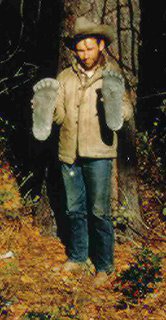
In March 2004, a book came out called
The Making of Bigfoot: The Inside Story written by Greg Long which purported to expose the famous Patterson/Gimlin film as a hoax. The so-called "guy-in-the-suit" was an individual by the name of Bob Heironimus, a former Pepsi truck driver who actually tried to come out with his story of the alleged hoax in 1999, but somehow couldn't find the right avenue other than the Yakima Herald. Heironimus was a bit evasive with Long, who was told by several people in the Yakima area that Heironimus was the "guy-in-the-suit" in the P/G film. Long went and interviewed Heironimus but didn't get much out of him other than, "Well, maybe I was in the suit, maybe I wasn't." This was in 1998, shortly before Heironimus came out with his story. Heironimus than told Yakima Herald reporter David Wasson that he was the guy in the suit, but was not identified in the story. Heironimus had seen a special called "World's Greatest Hoaxes: Secrets Finally Revealed" on Fox which showed a gentleman named Jerry Romney who was identified as the guy in the suit because he is tall, nearly 7 foot. Romney flat-out denied that. The news story really didn't go anywhere until 2001, when Long reinterviewed Heironimus and Bob finally admitted that he was the alleged guy in the suit. He described how it was done, with a 3-piece horsehide suit Patterson skinned. He alleged he slipped it over like a t-shirt and wore it in the film. He also alleged that both Roger Patterson and Bob Gimlin were in on it; interestingly enough, Gimlin lives only a few doors down from Heironimus. He also claimed that he would practice the walk in Patterson's backyard in the suit, with Gimlin and Mrs. Patterson looking on. Heironimus is 6'0" tall; the creature in the film has been measured as standing at least 7'3" tall. How can Heironimus be the guy in the suit? Anyway, Heironimus made his worldwide debut on the
Jeff Rense radio program on March 1, 2004. The book by Long debuted a few weeks later. Unfortunately for Heironimus, several facts emerged that contradicted his story; for instance, Philip Morris in the book said that the suit was in 6 pieces and made of Dynel. Also, Heironimus claimed in the book he wore some kind of slippers for the feet, but on MSNBC's
Countdown with Keith Olbermann he said he was in his stocking feet. He also went along with the Morris story on
Countdown. He then went on to KATU-2 in Portland, Oregon and was quoted as saying that the suit designer for
Planet of the Apes, John Chambers, designed the "Patty" suit. Then, it was revealed that Heironimus' sister had called Mrs. Patricia Patterson and asked her to go along with a story of her brother wearing a
grey horsehide suit in the film so they would all make money off it. Besides this, Heironimus could not even remember the most basic things about how long it would take to get from the main road to the film site, which is not a half-mile as he claimed, but 22 miles over rough mountain roads. Besides all this, it was
Bob Gimlin's idea to go to the film site to begin with, so how could it have been a hoax, especially if Roger Patterson was supposed have been the guy planning it with Bob H.? So the title of this essay, "Is Bob Heironimus telling the truth?" can be answered with a definitive
"No!
"






